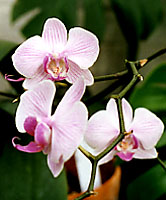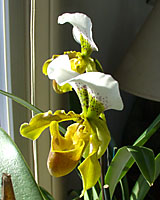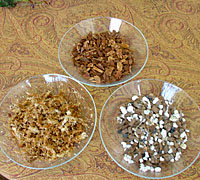Terry L. Ettinger Horticulture Consulting Services
Meeting The Needs Of Today With A Vision For The Future
Question of the Week
Orchid Basics
 Q. My girlfriend gave me an orchid plant for Christmas because they're my favorite flower. However, the plant
came with no instructions and I have absolutely no idea how to care for it. Thanks in advance for any advice you can provide.
Q. My girlfriend gave me an orchid plant for Christmas because they're my favorite flower. However, the plant
came with no instructions and I have absolutely no idea how to care for it. Thanks in advance for any advice you can provide.
A. I have to admit that the answer I'm offering here is based on what I've read and gleaned from orchid enthusiasts through the years, as I've never grown an orchid myself. Our home simply stays much too cool during the winter months to grow them well, if at all.
First, it's quite possible that you received a Phalaenopsis orchid from your girlfriend. These relatively easy-to-grow plants are often referred to as "moth" orchids as their flower petals are thought to look like moths in flight. They're also often irresistible when found in full bloom at many home improvement centers and grocery stores during the winter months.
 As to their care a general rule of thumb is that if you're comfortable, they're comfortable. In other words, these
orchids prefer temperatures that range from 70 to 80 degrees during the day, then drop to around 60 to 65 degrees at night.
In fact, exposure to night temperatures in the 60's for three to four weeks in the fall triggers the formation of flower
spikes that then produce the long-lasting flowers during the winter months!
As to their care a general rule of thumb is that if you're comfortable, they're comfortable. In other words, these
orchids prefer temperatures that range from 70 to 80 degrees during the day, then drop to around 60 to 65 degrees at night.
In fact, exposure to night temperatures in the 60's for three to four weeks in the fall triggers the formation of flower
spikes that then produce the long-lasting flowers during the winter months!
Moth orchids also do not like to grow in bright sunlight except on the odd winter day when the sun is shining (at left, above). In fact, they're very tolerant of light levels so low that you can just make out a slight shadow when you place your hand between their leaves and a source of light - a real attribute when growing these plants in a window during the short, overcast days of midwinter here in Central New York.
 Like holiday cacti, most orchids are epiphytes. This means they're found growing in decomposing leaves, bark and other
debris that accumulates in cracks and crevices in the trunks and branches of trees in tropical forests. To match these "soil"
conditions, your new orchid should be grown in (left to right, at left
above) coarse moss peat, medium coarse fir bark, or in
specific "orchid" potting mixes that contain ground coconut hulls, coarse perlite, charcoal and other fast-draining, yet
water-retentive materials. The best time to repot orchids is in March or April,
just before longer days and warmer weather
triggers new growth.
Like holiday cacti, most orchids are epiphytes. This means they're found growing in decomposing leaves, bark and other
debris that accumulates in cracks and crevices in the trunks and branches of trees in tropical forests. To match these "soil"
conditions, your new orchid should be grown in (left to right, at left
above) coarse moss peat, medium coarse fir bark, or in
specific "orchid" potting mixes that contain ground coconut hulls, coarse perlite, charcoal and other fast-draining, yet
water-retentive materials. The best time to repot orchids is in March or April,
just before longer days and warmer weather
triggers new growth.
Water orchids only when the potting soil surface feels dry to the touch - maybe only once a week - from October through March. Then, from April through August when your plant is growing more actively you may need to water it every three or four days with a very dilute fertilizer solution (e.g., one teaspoon of water-soluble 20-20-20 houseplant fertilizer per gallon of water).
Finally, for more information on growing orchids in Central New York and links to other orchid organizations, visit the Central New York Orchid Society website. The group has monthly meetings as well as several shows throughout the year.
Finally, why you may think that orchids grow only in exotic tropical regions of the world, that's far from the case. In fact, about 60 species of orchids are native to New York - and some may be growing in the woods practically right outside your door! To learn more about our native orchids, go to The Native Orchids of New York State website maintained by the SUNY College of Environmental Science & Forestry Roosevelt Wild Life Station.